In Outlook on the web, you can use the search bar at the top of the page to search for email messages and people.
When you use search from your mailbox, the results will include messages, contacts, and files.
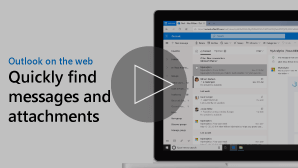
Note: If the instructions don't match what you see, you might be using an older version of Outlook on the web. Try the Instructions for classic Outlook on the web.
-
In the Search box in Mail, type what you want to search for (a contact, subject, part of a message, or name of a file) and press Enter.

-
When you're done with the search, select


-
Start typing a name in the Search box. Choose from the suggested people in the list below the Search box, or press Enter to see more results.
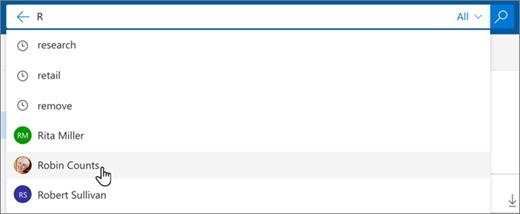
-
When you select a contact in the search results, you'll see a list of email messages related to that contact.
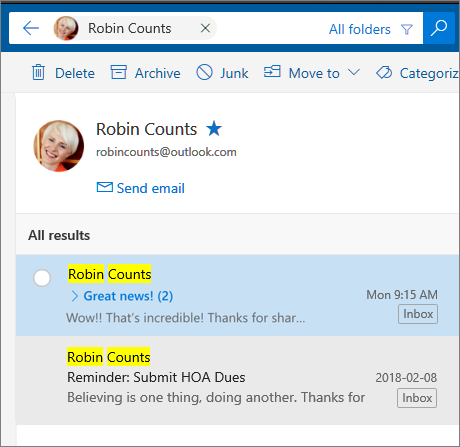
To send a message to your contact, select Send email below the contact's name. To add the contact to Favorites, select

If you often search for email from the same people, you can add those people to Favorites. To add the contact to Favorites, search for that contact, select their name in the search results, and then select 
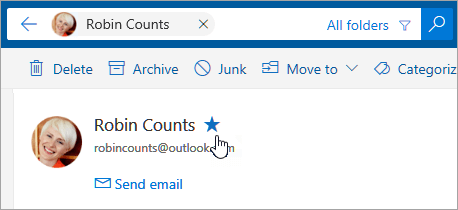
To see all email messages from that person, select their name under Favorites in the left pane.
You can use Search filters to refine your search with options like Folders, From, To, Subject, keywords, date ranges, and attachments. To use search filters, select Filters 
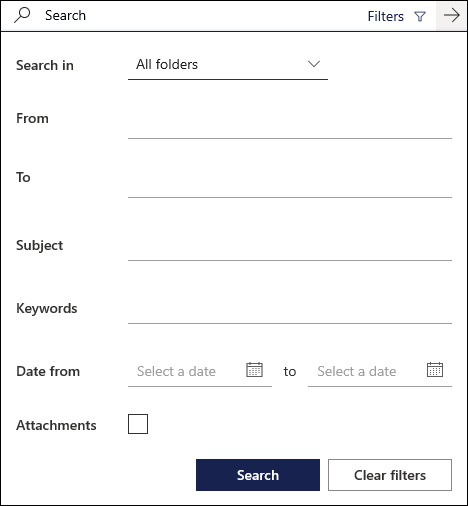
Instructions for classic Outlook on the web
-
Enter your search keyword in the Search Mail and People box.
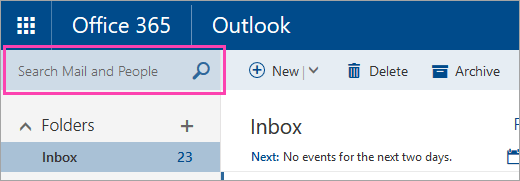
-
Select one of the suggested messages or contacts, or press Enter to see all the possible results.
Tip: If you're searching for a contact, choose the Search People link at the bottom of the list of suggestions to limit the search to your contacts and your organization’s directory.
After you enter your keyword, you can refine your search to only include email messages in a certain folder, from a specific sender, with attachments, or within a certain date range.
-
To clear your search results, move your cursor over the search box and select Discard

After you enter your search keyword, you can use the navigation pane to refine your search results:
-
In folders: Only search for messages in a specific folder, such as Inbox, Sent Items, and Archive.
-
From: Only search for messages from a specific sender.
-
Options: Only search for messages that match certain criteria, such as messages with attachments.
-
Date: Only search for messages within a certain date range.
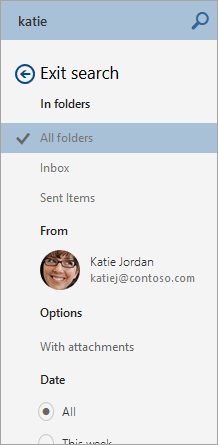
When you enter a name in the Search Mail and People box in Mail, a Search People option appears. Selecting this option lets you search in People, where your search results will be limited to your contacts and your organization's directory.
To search in People:
-
In the Search Mail and People box, type the name of the person, group, or resource you want to search for, and press Enter.
-
At the bottom of the search results, select Search People.
-
Refine your search by searching only in Your contacts or Directory.
-
To clear your search results, move your cursor over the search box and select Discard

Use Advanced Query Search to refine results
Use Advanced Query Search (AQS) to refine your search results. In the search box, type an AQS keyword from the table below, followed by a colon and what you want to search for. For example, to find messages with a subject that contains “report,” enter subject:report in the Search Mail and People box.
|
AQS keyword |
Description |
Example |
|
From |
Searches the From field. |
From:JerriFrye |
|
To |
Searches the To field. |
To:JerriFrye |
|
Cc |
Searches the Cc field. |
Cc:JerriFrye |
|
Bcc |
Searches the Bcc field. |
Bcc:JerriFrye |
|
Participants |
Searches the To, Cc, and Bcc fields. |
Participants:JerriFrye |
|
Subject |
Searches the subject. |
Subject:report |
|
Body or Content |
Searches the message body. |
Body:report |
|
Sent |
Searches the date sent. You can search for a specific date or a range of dates separated by two dots (..). You can also search for relative dates: today, tomorrow, yesterday, this week, next month, last week, past month. You can search for the day of the week or month of the year. Important: Date searches must be entered in month/day/year format: MM/DD/YYYY. |
Sent:01/01/2017 |
|
Received |
Searches for the date received. You can use the same search terms as for Sent. |
Received:01/01/2017 |
|
Category |
Searches the Category field. |
Category:reports |
|
HasAttachment:yes |
A search for HasAttachment:yes returns only email messages with attachments. To further specify the email messages you want to search, use words or names from the mail in conjunction with the search keyword. For example, blue hasattachment:yes would return only email messages containing the word "blue" that include attachments. |
report HasAttachment:yes |
|
HasAttachment:no |
A search for HasAttachment:no returns only email messages without attachments. |
report HasAttachment:no |
|
IsFlagged:yes |
A search for IsFlagged:yes returns only email messages that are flagged. |
report IsFlagged:yes |
|
IsFlagged:no |
A search for IsFlagged:no returns only email messages that are not flagged. |
report IsFlagged:no |
When you use AQS, you can search on multiple search terms, including any, all, or an exact phrase.
-
Subject:product plan will find any message with “product” or “plan” in the subject.
-
Subject:(product plan) will find any message with both “product” and “plan” in the subject.
-
Subject:“product plan” will find any message with the phrase “product plan” in the subject.
You can also use AND or OR to search on multiple search terms. For example, you could search for messages from Jerri that include "report" in the subject by entering From:Jerri AND Subject:report in the search box.
Tips, tricks and more
Use these tips and tricks to improve the search responses.
-
Keyword searches are not case sensitive. For example, cat and CAT return the same results.
-
When searching on a property:value expression, don't put a space after the colon. If there is a space, your intended value will just be full-text searched. For example, to: JerriFrye searches for "JerriFrye" as a keyword, rather than for messages that were sent to JerriFrye. To search for messages sent to JerriFrye, enter to:JerriFrye.
-
A space between two keywords or two property:value expressions is the same as using AND. For example, from:"Jerri Frye"subject:reorganization returns all email messages sent by Jerri Frye that contain the word reorganization in the subject line.
-
When searching a recipient property, such as To, From, Cc, or Recipients, you can use an SMTP address, alias, or display name to denote a recipient. For example, you can use JerriFrye@contoso.com, JerriFrye, or "JerriFrye".
-
You can use only suffix wildcard searches—for example, cat* or set*. Prefix wildcard searches (*cat) or substring wildcard searches (*cat*) aren’t supported.
-
When searching a property, use double quotation marks (" ") if the search value consists of multiple words. For example, subject:budget Q1 returns messages that contain budget in the in the subject line and Q1 anywhere in the message or in any of the message properties. Using subject:"budget Q1" returns all messages that contain budget Q1 anywhere in the subject line.
-
To exclude content marked with a certain property value from your search results, place a minus sign (-) before the name of the property. For example, -from:"Jerri Frye" will exclude any messages sent by Jerri Frye.
-
To keep Outlook running smoothly, only the first 1,000 search results are returned. If the results list doesn’t contain what you’re searching for, try a more specific search.










